View our Guide How to Build a Marketplace in 10 weeks x


Did you know that there are more than 10 billion dollar worth of transactions happening on top service marketplaces every year? The industry is growing and so are the number of freelancers, tech pros and small companies.
Today, marketplaces offer an alternative to this outdated way of doing things. Service marketplace companies make it possible for sellers to match with potential buyers in a matter of minutes.
And it’s important to understand that the marketplace model is not limited to the sale of products. Looking back on many years of our experience with building service marketplaces, you should look into this type of marketplace model if you want to broaden your potential client base.
In this article, we will tell you about marketplace model in service economy, challenges, specifics and tips you need to follow for build a service marketplace successfully.
Table of content:
A marketplace is an online platform where you can buy and sell products. It helps buyers and sellers connect, and it makes it easy for them to do business with each other.
A online marketplace is like a giant mall or grocery store—you can buy just about anything you want from it. You don't have to go to different stores or websites to find what you need; instead, all of that information is in one place, so you don't have to waste time searching for what you want!
Marketplaces are great because they help people find exactly what they need at a reasonable price. They also make sure that the seller gets paid and the buyer gets what they ordered in good condition.
Airbnb and Uber are two very popular examples of service marketplace companies. Product marketplaces and service marketplaces are two very different types of platforms. Unlike a product, a service is intangible, inseparable, and time- and location-specific. Unlike a product, a service requires customer involvement – customers in this case have to set their schedules around the time that the services will be offered. Therefore, a service marketplace needs to offer a wide range of times at which it can be consumed or delivered (like Uber allowing you to stop anywhere). Similarly, whereas on product marketplaces, the shopping experience revolves around the shopping cart, on service marketplaces, it depends heavily on timing (when will you be available to get Uber?) and the availability of the service provider (Airbnb has tens of thousands of hosts around the world). Product marketplaces have to be particularly vigilant about inventory levels and supply chain issues. Service marketplaces have to be mindful about geographical coverage – For example Uber needs to make sure it can meet demand wherever customers need it.
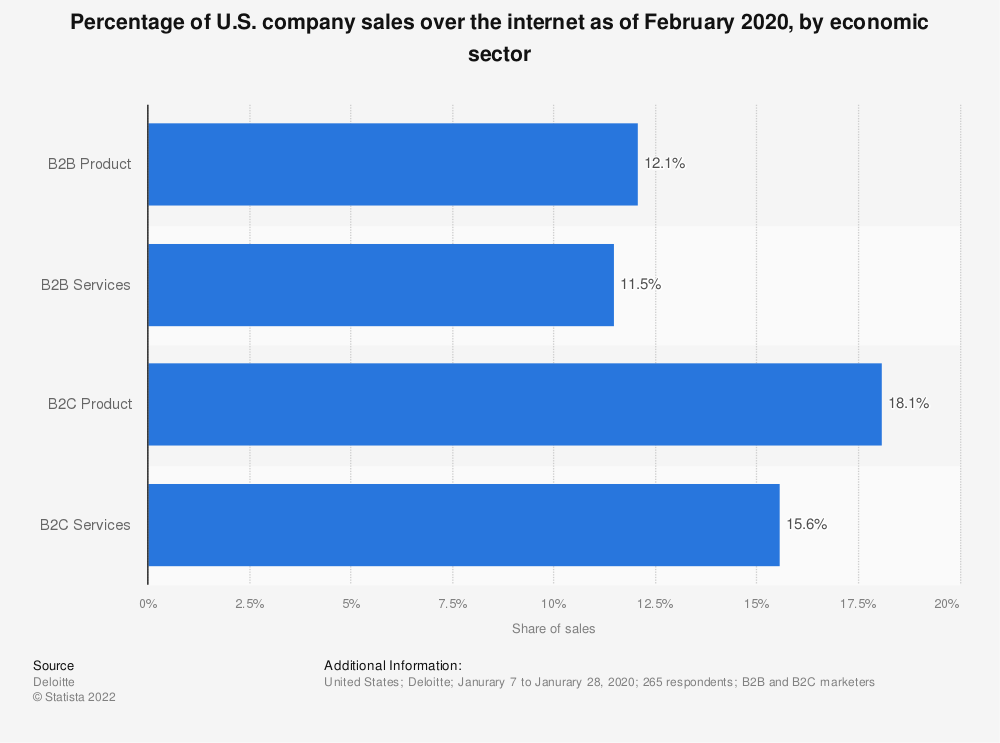
Marketplace is a great option for the service economy. Whether you're a seller, vendor, or buyer, there are plenty of benefits to choosing build a service marketplace.

Marketplace owner benefit from the ability to move their business to the internet and reach an audience of millions of people. They also gain visibility, which helps them get more customers and grow their business.
Vendors can benefit from partnering with marketplace, increasing their visibility and gaining buyers' loyalty. They can also optimize costs by offering discounts and promotions in real-time through the marketplace's platform.
Buyers benefit from advanced search functionality that allows them to compare different vendors easily, as well as simple customer journeys that help them find what they want quickly and efficiently.
The marketplace model can help you boost your business in a number of ways.
Service marketplace need more sellers than product marketplace
You already know that the product and service markets are different. But did you know that one of them is actually more scalable than the other?
Think about it. You can't sell products without having inventory—that's just not possible. But when it comes to service marketplaces, a lot of the inventory is created by the sellers themselves. So, while product marketplaces need more sellers than service marketplaces to achieve similar GMVs (gross merchandise values), service marketplaces need even more sellers than product marketplaces to achieve similar GMVs!
To see this, compare data from two giants: Amazon and Airbnb.
While Amazon only needs 2 million sellers to generate $386 billion, the service marketplace Airbnb needs 3 million sellers to generate $3.39 billion.
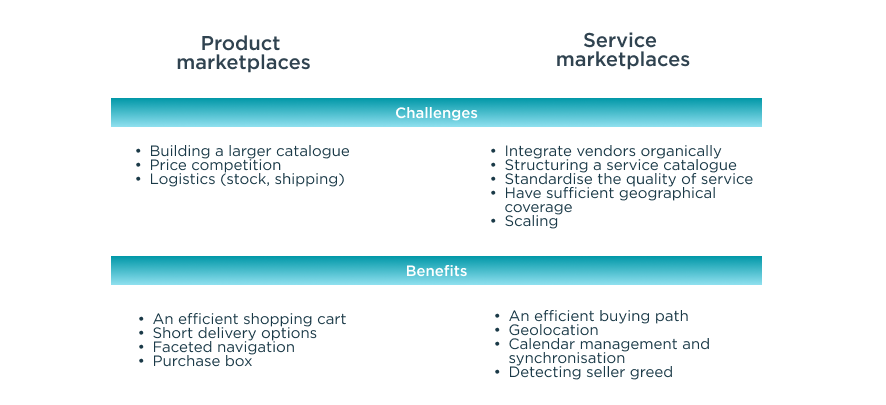
Relying on the marketplace model for the sale of services also offers many development opportunities and, therefore, success:
New markets can still be created. This is because you are selling to customers who are already interested in your product. They are already familiar with what it does and how it works, so you don't have to persuade them about the benefits of your service.
Barriers to entry are lower. When you sell a product, your competitors may be able to undercut your price or offer more features. With services, though, there is no such thing as a free lunch—you can't just cut corners on quality or delivery if you want to stay competitive.
Competition is weaker. Because competitors can't easily copy what they do or change their offerings overnight, they are less likely to pose much of a threat than they would be if they were selling products.
Margins are higher. The nature of services means that the cost per unit sold is fixed—once you've paid for all the materials needed to provide a service (including labor costs), there's no additional expense associated with each additional sale or customer acquisition cost involved with acquiring new ones!
Booking models refer to how services are booked in marketplace online.
The two main types of booking models are planned and on-demand.
Blind and open booking models refer to how much control the platform has over which supplier performs the service for each customer request.
To manage the execution of services in the best possible way, it is imperative to respect the rules of supplier management.
Opening hours: the days and times when the service is available.
Seasonal prices: if prices vary according to time and date.
Orderable quantities: if the service cannot be offered for more than a certain number of hours at a time. Time units (hour, day, night...): whether it is possible to book per day, at a daily price.
Response time: the time it takes for the supplier to confirm a booking.
Processing time: the time needed to process the requested service.
Turnaround time: the time is taken to perform the service.
Cumulative services: time is needed for service A and extra time if service B is added. Geolocation and geographical limits: the areas in which the service is available, with no overruns or overruns possible for an additional charge.
Place of performance: the service will be provided directly in the shop or at home.
Cancellations and refunds: Fees may or may not apply in the event of order cancellation.
We've all had this experience: you want to book an appointment online and the website tells you that it's unavailable. But the web page says that there are still some spots left for the day, so why can't you book it?
It's because service provision has its own rules for availability management, which determine when customers can actually make their appointments.
Here are a few common types of service provision:
Flat fee: The customer may book a flat fee service at any time within the available range if: [turnaround time] ≥ [start of service] - [start of next unavailability].
Based on the quantity available: the customer books the service at the beginning of the availability period. They cannot start the booking during the availability period.
Time-based: The customer books a service per unit (e.g., half an hour). He can book a single slot within the availability range, a more extended slot, or several non-sequential slots.
Commissions are the lifeblood of most b2c and b2b marketplaces. They allow for the marketplace operator to align the interests of sellers and customers, as well as provide a revenue stream that can be used to develop new features and services.
In commission-based business models, the fee is paid by a buyer or seller when an agreement is reached. This is advantageous because there are fewer barriers to entry for users, as they don't have to pay anything in advance.
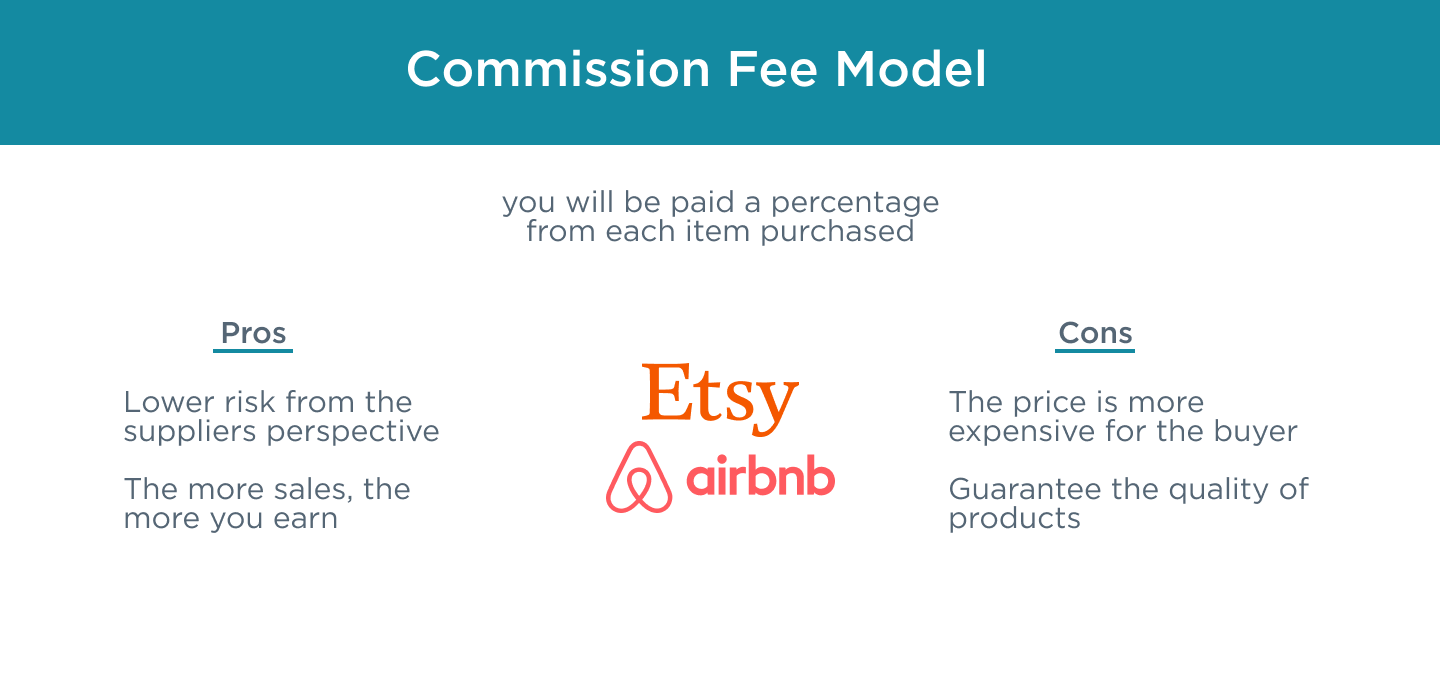
We all know how important recurring revenues are for businesses. When you can get customers to pay a monthly fee to use your product or service, it makes everything easier—you don't have to worry about upselling them, and you can focus on improving your product rather than worrying about how to make money from it.
But subscription models can be tricky for sellers. If they're not careful and don't give their customers enough information about what they're getting into, it's easy for sellers to lose money or even go out of business.
That's why we built Second—an open-source platform that lets you create your own marketplaces for services and rentals. It lets you offer both subscription and commission-based plans so that sellers can pick the one that works best for them.
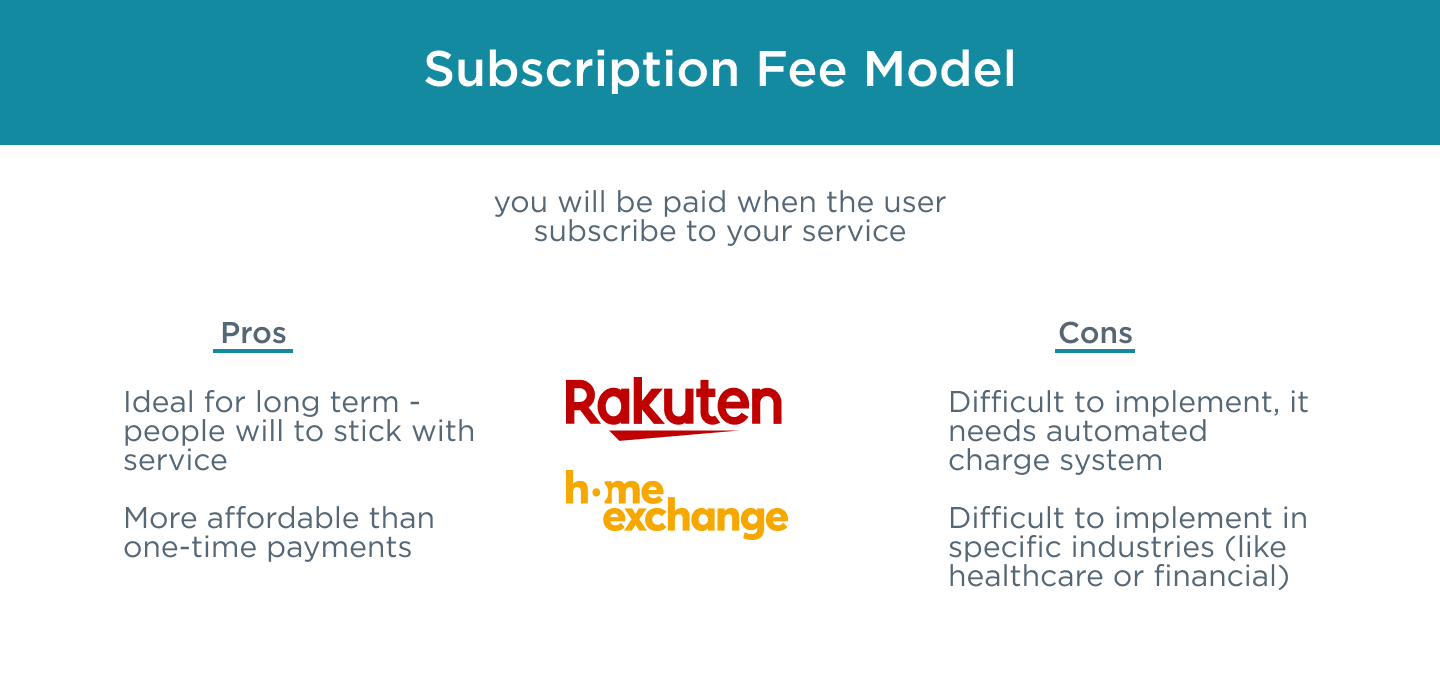
The listing fee business model is another approach to online b2b marketplace revenue. While commission-based marketplaces only charge commission if the item is sold, they may miss out on revenue from less popular merchandise. Listing fee models allow tackling this problem and getting profit from each ad on the platform.
Let's say you want to sell your old iPhone 8 for $300. You can list it on an auction site like eBay or Craigslist, but the commission fees can be really high—sometimes over 30% of the sale price! What if there was a way to get paid even if your item doesn't sell?
That's where listing fee models come in. Instead of charging you every time you sell something, they only charge you when you list an item. This means that even if people don't buy what you have for sale, it's still worth your time and effort because there's no risk involved!
It is the most common business models, it you want to know more about them check out detailed article 7 Marketplace Business Models.
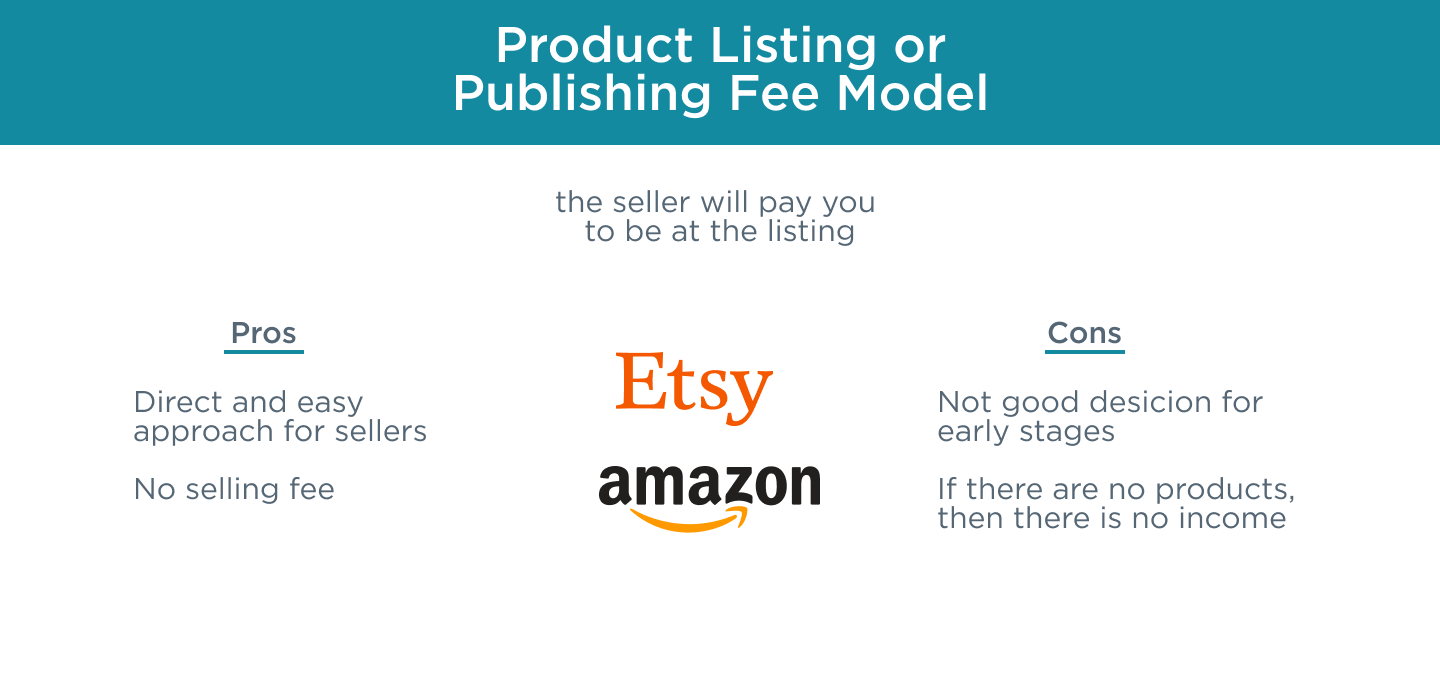
When a buyer purchases a product, the sale is complete when the product has been shipped to the customer. However, when a buyer purchases a service, it's not complete until the service has been produced.
To understand the flow of payments, the marketplace operator must have full knowledge of how the service is executed. The impact of service delivery on the flow of funds in the operation of a marketplace is that there are two distinct stages: (1) payment and (2) fulfillment/delivery/performance.
Turnaround time: the period between the client’s request and the service delivery.
Response time: waiting for confirmation from the supplier
Pre-buffer: the time between confirmation and the start of the execution of the service.
Post-buffer: time available for the customer to refuse the service.
Processing time: time is taken to complete the service
Cancellable: the customer can cancel the order; refunds may vary.
Rejectable: the customer can request a refund, which requires validation by the marketplace operator. Pre-authorisation: allows the amount of the purchase to be withheld without being debited.
Escrow: funds are debited and held on the marketplace’s escrow service.
Payment: the funds are paid to the seller.
Choosing a marketplace development company can be a difficult decision. When it's time to build service marketplace, you have several options.
1) Build it yourself with a team of developers for months. It takes a lot of effort and costs. If you were planning to scale specific niche, during this time, already someone could have realized the idea three times and became your competitor.
2) Use a ready-to-go marketplace solution so that you can get your MVP up and running in weeks instead of months.
If you go with the latter option, we recommend our marketplace builder solution.
Our solution can help you start the marketplace if...
Marketplace Builder is a solution that lets you quickly and easily launch your marketplace in less than 10 weeks. Features included:
And if you need features that are not on the list, we can discuss the possibility of developing individual features for you.
Here’s what some of our customers have to say about ByteAnt Marketplace Builder:
“Our platform serves as a marketplace for users to shop for Swiss software vendors. Visitors can use selectable parameters to navigate over 1,000 vendors with 2,500 products, 2,500 references, and 2,000 edited posts.
Without this project, our business would not exist anymore. This platform is the backbone of our company. ByteAnt uses agile methodology and project management tools to produce high-quality work efficiently. We always can rely on our close relationship and work together in an efficient way.” - Marcel Siegenthaler, TopSoft
Today, the service marketplace is growing in popularity because it is supported by a tech-savvy generation that is always connected to the internet. Millions of people around the world are investing and setting up their own business. If you develop your service marketplace, you can reach out to all these consumers. You can earn more for your service business and run it easily.
Today's digital marketplace is a great place to be, as it brings together service providers and buyers/clients/users. There is no doubt that this partnership will continue to benefit users, making it easier to find the best outfits for the job needed. This movement toward online shopping represents a shift in values toward efficiency and waste reduction. The future is bright and busy, so get started on yours today!
If you have any questions or would like to talk about marketplace software development for your specific project, please let us know. We're here to help our customers get started on their ideas as quickly as possible.
and get the latest updates